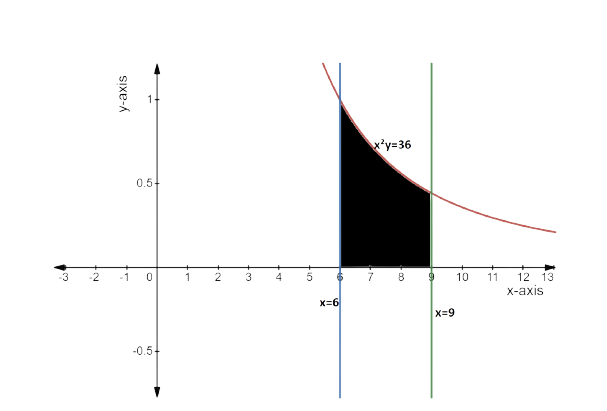
The area enclosed by the curve ${x^2}y = 36$, the $x - axis$ and the lines $x = 6$ and $x = 9$ is
A. $6$
B. $1$
C. $4$
D. $2$
Answer
217.5k+ views
Hint: In this question, we are given the equation of the curve i.e., ${x^2}y = 36$ and the lines. We have to find the area bounded by them. Firstly, plot the graph of the following. Then, for the area integrate the equation of the curve in terms of $x$ with respect to $dx$ from $x = 6$ to $x = 9$. Solve it further using integration and logarithm formulas and resolve the limits.
Formula Used: Integration formula –
$\int {cdx = cx} $ where $c$ is the constant
$\int {{x^n}dx = \dfrac{{{x^{n + 1}}}}{{n + 1}}} $
Complete step by step solution: Given that,
Equation of the curve ${x^2}y = 36$ and the equation of the lines $x = 6$ to $x = 9$.
Equation of the curve also written as $y = \dfrac{{36}}{{{x^2}}}$.
Graph of the given equations is attached below (figure 1);

Figure 1: A Graph contains the plot of the given curve and the lines
Now, as you can see bounded area is under the equation of the curve from the equation of both the lines.
Therefore, the area of the bounded region will be the integration of the equation of the given curve in terms of $x$ i.e., $y = \dfrac{{36}}{{{x^2}}}$ with respect to $dx$ from $x = 6$ to $x = 9$.
Thus, the area of the required region will be
$A = \int\limits_6^9 {\left( {\dfrac{{36}}{{{x^2}}}} \right)dx} $
As we know that, $\int {cdx = cx} $ where $c$ is the constant and $\int {{x^n}dx = \dfrac{{{x^{n + 1}}}}{{n + 1}}} $
It implies that,
$A = 36\left[ {\dfrac{{ - 1}}{x}} \right]_6^9$
On resolving the limits, we get $A = 36\left[ { - \dfrac{1}{9} - \left( { - \dfrac{1}{6}} \right)} \right]$
On solving, we get $A = 2$ square units
Hence, Option (D) is the correct answer i.e., $2$ sq. unit
Option ‘D’ is correct
Note: Different methods are used to determine the area under the curve, with the antiderivative method being the most prevalent. The area under the curve can be calculated by knowing the curve's equation, borders, and the axis surrounding the curve. There exist formulas for obtaining the areas of regular shapes such as squares, rectangles, quadrilaterals, polygons, and circles, but no formula for finding the area under a curve. The integration procedure aids in solving the equation and determining the required area. Antiderivative methods are highly useful for determining the areas of irregular planar surfaces.
Formula Used: Integration formula –
$\int {cdx = cx} $ where $c$ is the constant
$\int {{x^n}dx = \dfrac{{{x^{n + 1}}}}{{n + 1}}} $
Complete step by step solution: Given that,
Equation of the curve ${x^2}y = 36$ and the equation of the lines $x = 6$ to $x = 9$.
Equation of the curve also written as $y = \dfrac{{36}}{{{x^2}}}$.
Graph of the given equations is attached below (figure 1);

Figure 1: A Graph contains the plot of the given curve and the lines
Now, as you can see bounded area is under the equation of the curve from the equation of both the lines.
Therefore, the area of the bounded region will be the integration of the equation of the given curve in terms of $x$ i.e., $y = \dfrac{{36}}{{{x^2}}}$ with respect to $dx$ from $x = 6$ to $x = 9$.
Thus, the area of the required region will be
$A = \int\limits_6^9 {\left( {\dfrac{{36}}{{{x^2}}}} \right)dx} $
As we know that, $\int {cdx = cx} $ where $c$ is the constant and $\int {{x^n}dx = \dfrac{{{x^{n + 1}}}}{{n + 1}}} $
It implies that,
$A = 36\left[ {\dfrac{{ - 1}}{x}} \right]_6^9$
On resolving the limits, we get $A = 36\left[ { - \dfrac{1}{9} - \left( { - \dfrac{1}{6}} \right)} \right]$
On solving, we get $A = 2$ square units
Hence, Option (D) is the correct answer i.e., $2$ sq. unit
Option ‘D’ is correct
Note: Different methods are used to determine the area under the curve, with the antiderivative method being the most prevalent. The area under the curve can be calculated by knowing the curve's equation, borders, and the axis surrounding the curve. There exist formulas for obtaining the areas of regular shapes such as squares, rectangles, quadrilaterals, polygons, and circles, but no formula for finding the area under a curve. The integration procedure aids in solving the equation and determining the required area. Antiderivative methods are highly useful for determining the areas of irregular planar surfaces.
Recently Updated Pages
Elastic Collision in Two Dimensions Explained Simply

Elastic Collisions in One Dimension Explained

Electric Field Due to a Uniformly Charged Ring Explained

Electric Field of Infinite Line Charge and Cylinders Explained

Electric Flux and Area Vector Explained Simply

Electric Field of a Charged Spherical Shell Explained

Trending doubts
JEE Main 2026: Application Form Open, Exam Dates, Syllabus, Eligibility & Question Papers

Derivation of Equation of Trajectory Explained for Students

Hybridisation in Chemistry – Concept, Types & Applications

Understanding the Angle of Deviation in a Prism

Understanding Collisions: Types and Examples for Students

How to Convert a Galvanometer into an Ammeter or Voltmeter

Other Pages
JEE Advanced Marks vs Ranks 2025: Understanding Category-wise Qualifying Marks and Previous Year Cut-offs

NCERT Solutions for Class 11 Maths Chapter 10 Conic Sections

NCERT Solutions for Class 11 Maths Chapter 9 Straight Lines

NCERT Solutions For Class 11 Maths Chapter 8 Sequences And Series

NCERT Solutions For Class 11 Maths Chapter 12 Limits And Derivatives

Understanding Atomic Structure for Beginners




